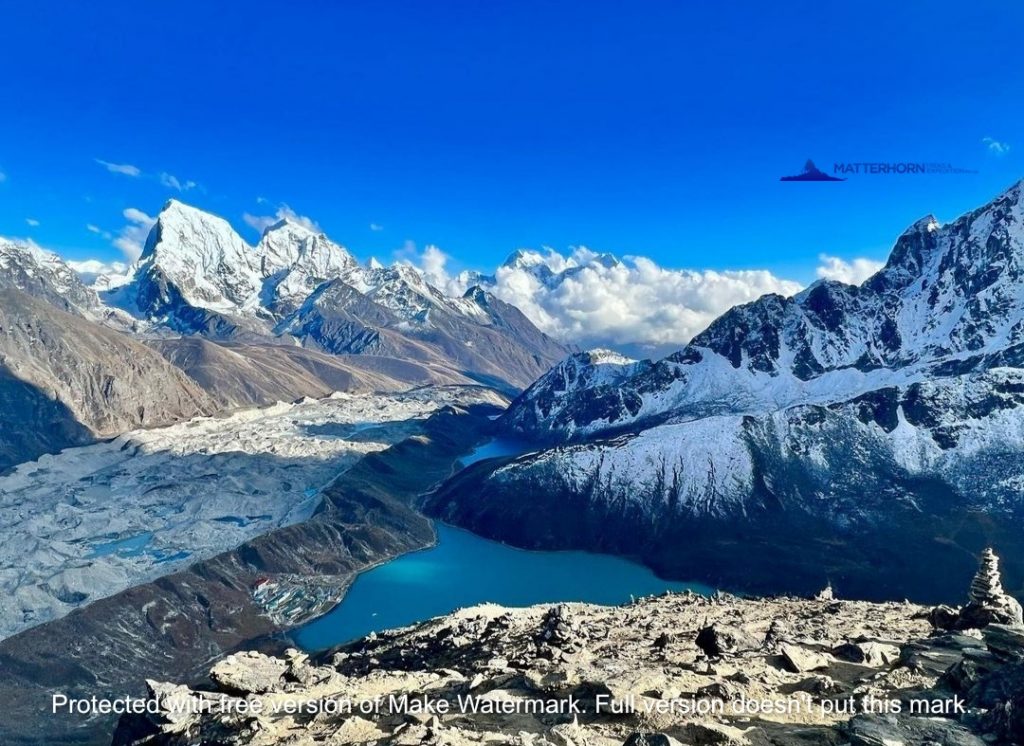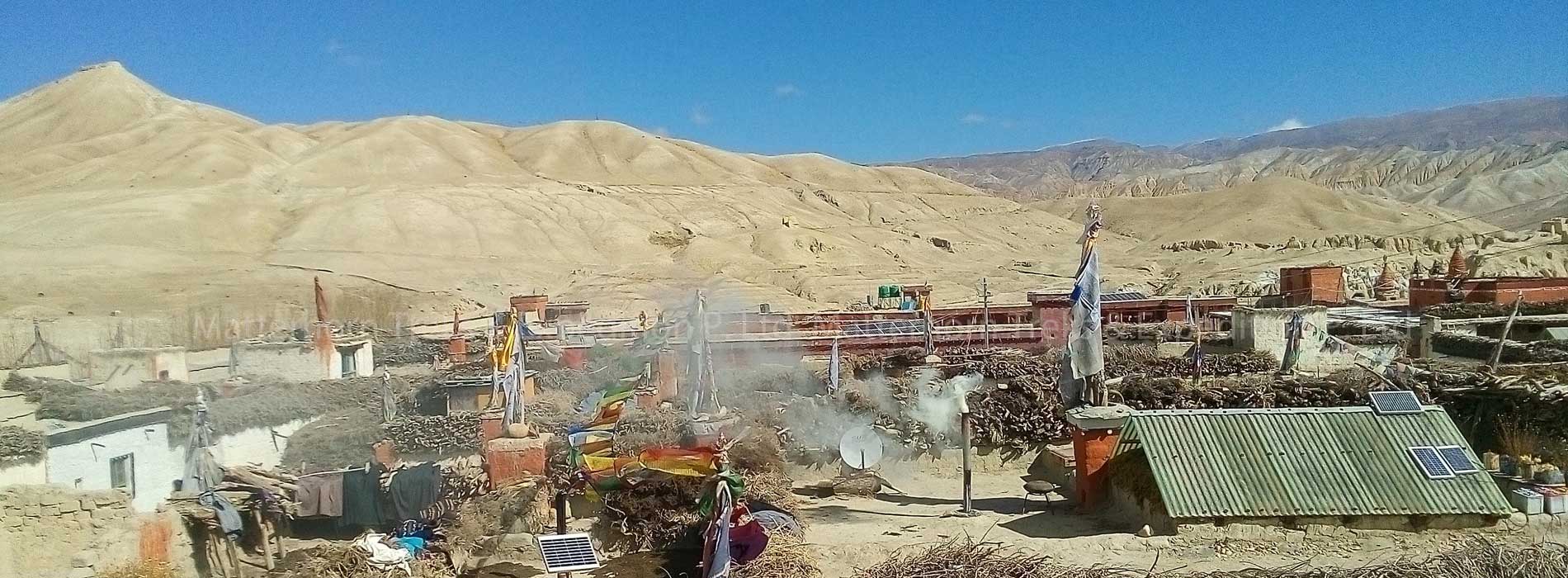
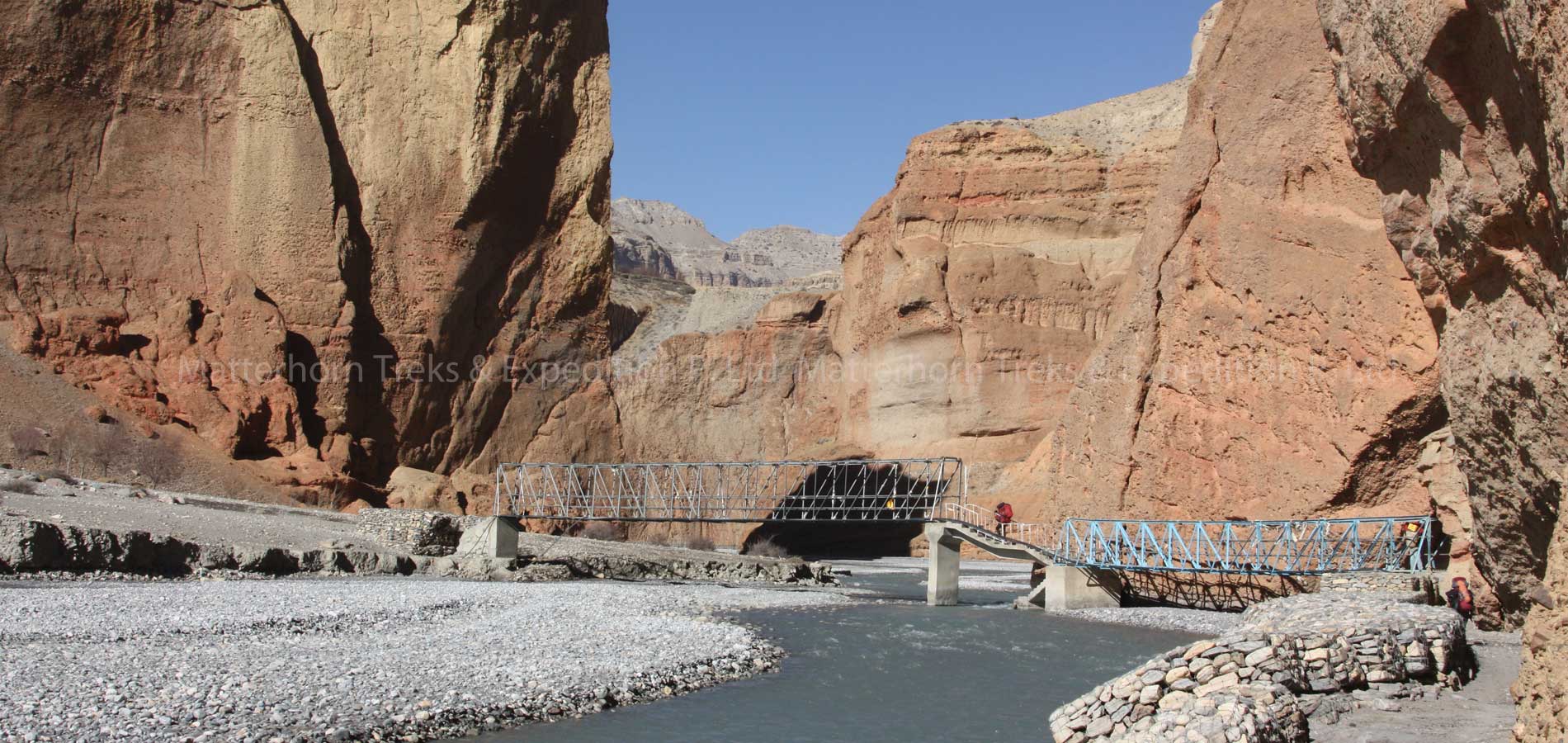
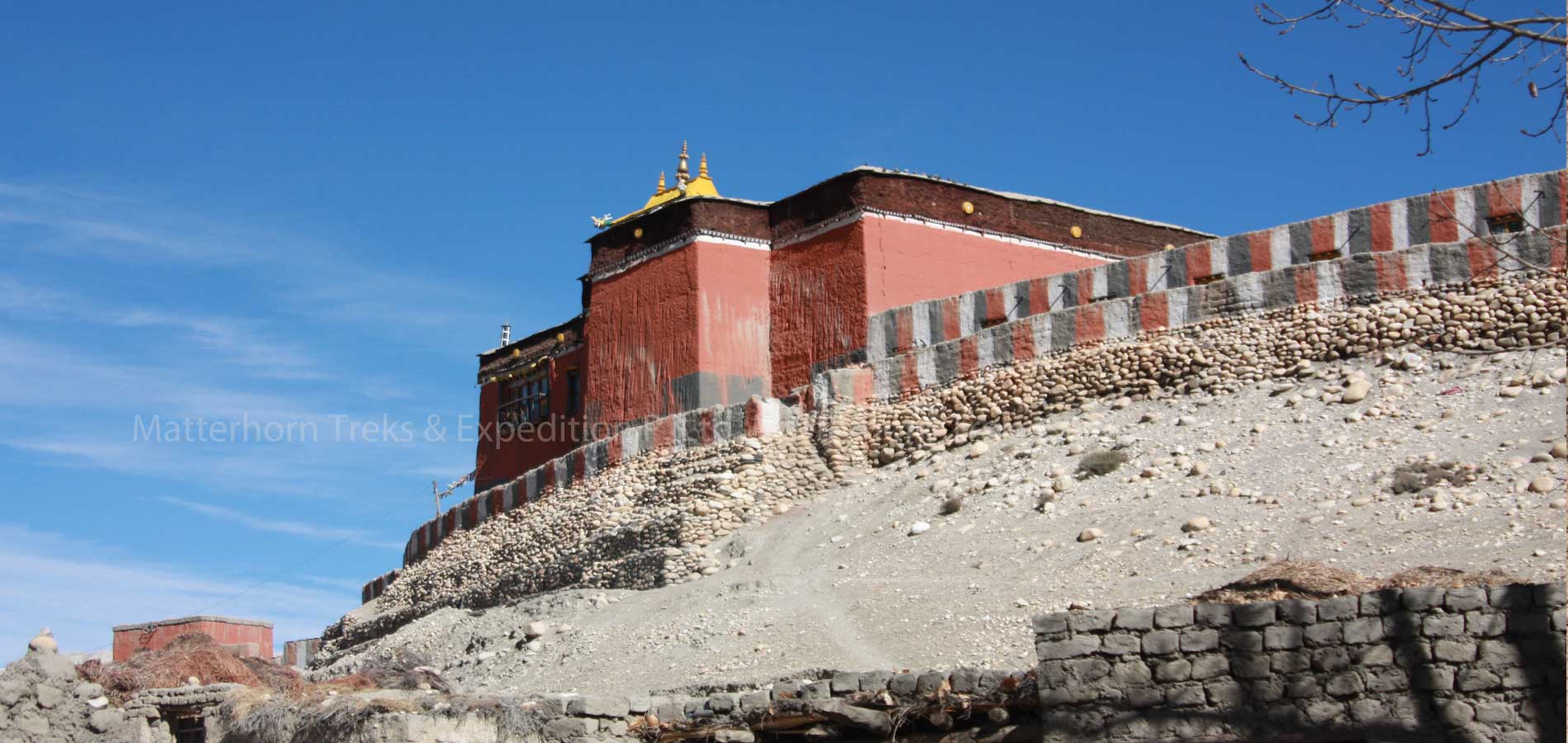
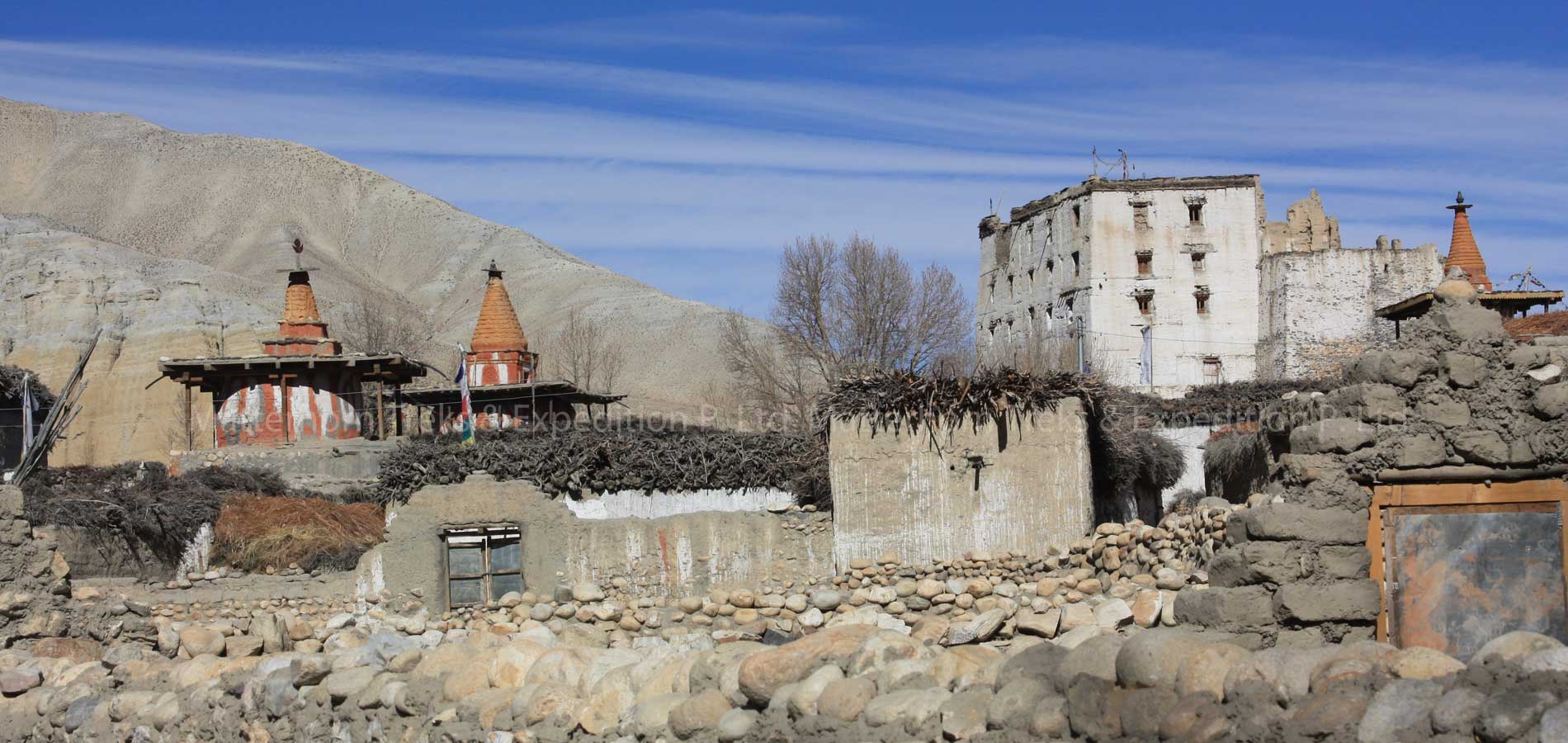
Mustang is a remote, semi-independent Tibetan kingdom within the territory of Nepal (just north of the Annapurna Region on theTibetan border), and one of the last bastions of undisturbed Tibetan culture in the world follows the trail on Mustang which lies beyond the Annapurna and Dhaulagiri massif in central Nepal is the hidden kingdom of Mustang, an intriguing scorched region, forming part of the Tibetan plateau.
Untouched by the outside world, 16th century monasteries remain active, adorned with unrivalled frescoes, thankas and status of gigantic deities, preserving ancient traditions. Mustang is the land of Barley field’s pasture for grazing herds. These upper reaches the Kali Gandaki River, which has tantalized a generation of trekkers – have recently been opened in 1992. Mustang being a restricted area, there are certain formalities required by the government of Nepal in obtaining a special permit.
Day 1: Arrival in Kathmandu (Elevation: 1300 m)
Arrival in Kathmandu Tribhuvan International Airport, a representative from Matterhorn Treks & Expedition will transfer to your hotel, We will brief about your trip activities. You’ll have rest of the day at leisure & Overnight at Hotel.
Day 02: Kathmandu Sightseeing
Sightseeing in Some of landmarks that are the World Heritage Sites of Kathmandu Durbar Square, the sacred Hindu temple of Pashupati Nath, the famous ‘Monkey Temple’ (Swayambhu Nath) and Buddhists shrine (Bouddha Nath). You can also make your last minute buying of personal items and preparation for the next day. Overnight at Hotel
Day 03: Drive to Pokhara ( Elevation: 820 m/Drive : 7-8 hrs)
Trekking staff will arrive at your hotel at 6:30 am to pick you up to tourist bus station for journey to Pokhara. Normally bus leave at 7:00 am from Kantipath and it takes about 7 hours from Kathmandu. Today, you can take a breakfast in your hotel that you order earlier night or request to manage packing breakfast that you eat in bus journey because on the way we are not stopping for breakfast as well not available good breakfast but we stop for a lunch so try to eat Nepalese food (Dal Bhat). Afternoon you arrive in Pokhara then check in your hotel and refresh and look around lakeside. Pokhara is a beautiful valley, with panoramic views of Annapurna, Machhapuchare (shape of fish tail) in the north, Dhaulagiri in the west, Lamjung Himal and Manaslu in the east. The town of Pokhara is set on the banks of the Phewa Lake. It is smaller and much less hectic than Kathmandu providing the perfect starting point for our trek. Overnight in Hotel
Day 04: Flight from Pokhara to Jomsom, then trek to Kagbeni (Elevation: 2800 m, Trek Distance: 10.7 km, Trek hour: 3-4 hrs)
Early morning transfer to Pokhara airport, fly to Jomsom. This is one of the world’s exciting flights to see mountain closely through the tiny aircraft, Annapurna I 8091 meters, Dhaulagiri 8167 meters, fishtail 6997 meter and other numerous peaks. You begin your trek to Kagbeni following along the bank of Kali Gandaki River. En- route, you pass through arid part of Kali Gandaki River with beautiful Ekle Bhatti. Kagbeni people are influence with more Tibetan and also Kagbeni is gateway for Upper Mustang and Damodar Kunda trekking. After reaching at Kagbeni (2800 m) there is oldest monastery so better to visit this monastery and look around Kagbeni village.
Day 05: Kagbeni trek to Chele (Elevation: 3050 m, Trek Distance: 15.3 km, Trek hour: 5-6 hrs)
Today trek trail starts with a special permit check up and on wards to the riverbank of Kali gandaki up stream. During the trek we have scenic picturesque place to stop through the sandy and windy trails. This trails follows the up and downhill. Firstly we reach Tangbe village (3060 m) with narrow alleys among white washed houses, fields of buckwheat, barley, wheat and apple orchards. From there we trek forward to Chhusang (2980 m) and after crossing the river head up to the huge red chunk of conglomerate that has fallen from the cliff above, forming a tunnel through which the Kali gandaki follows. We head up to small ridges reach at Chele village (3050 m)
Day 06: Chele trek to Shyangbochen (Elevation: 3800 m, Trek Distance: 11.5 km, Trek hour: 5 hrs)
Today trek trail climb to Taklam La Pass (3,624 m) and Dajori La (3725 m) through plateaus and narrow stretches with views of Tilicho Peak, Yakawa Kang and Damodar Himal. Further descend a little to the village of Samar (3620 m). Climb the trail that goes above Samar village to the ridge then descending steeply to a stream. Another about 3 hrs easy walk takes us to Shyangbochen (3800 m). On the way, we relax along the surrounding of cool streams and juniper trees. Locals use the dried leaves of junipers as incenses to invite deities and start any auspicious work. We also pass by a cave famously known as Ramchung Cave.
Day 07: Shyangbochen trek to Ghami (Elevation: 3520 m, Trek Distance: 9.3 km, Trek hour: 5-6 hrs)
Today trek trail short gentle climb to the small pass (3850 m) then you will meet two trails one right hand side trail goes to Geling (3570 m) where available larger red Gompa and another left hand side trail goes directly to Nyi La Pass (4010 m) through Tamagaon (3710 m) Please consult with your guide for route recommendation. If you choose trail goes to Tamagaon will be shorter one but if you choose through Geling will be longer walk. Both trail flat and gentle up hill till Nyi La Pass (4010 m) then descend to the Ghami / Ghemi (3520 m), the third largest village in the Lo region. The trail is passing a chortens and local villages which are like Tibetan style of houses with open Varanda. You will passes on the trail poplar trees and fields of Barley.
Day 08: Ghami to Tsarang
Outside Ghami we see what is Mustang’s longest Mani wall – approximately 1000 m long and decorated with simple carvings, blending in well with the surrounding scenery. There is also a group of chortens standing in front of the red wall which forms the end of the valley. Again, the architecture here is like an organic extension of nature. According to legend when the famous Guru Rinpoche (Padmasambhava) came to the area and fought and destroyed a demon, its intestines landed at the site where the Mani wall stands, its lungs near the red cliffs behind and its heart at the spot where Mustang’s oldest monastery, Lo Gekar, was built. A steady climb takes us up a 3820 m pass, after which a lunar-looking desert stretches to the horizon. There is no sign of vegetation or human life here, only barren hill after barren hill with the same distinctively creepy beauty. The first indication of human presence we see next is the Tsarang chorten – the large red-painted Stupa is in the middle of the landscape and further down the monastery and the palace of Tsarang can be distinguished in the fields. A broad road leads to Tsarang, Mustang’s second town, with around 1000 inhabitants.
Day 09: Tsarang to Lo-Manthang (3810 m)
Today, trek trail to Lo-Manthang with a magnificent view of Nilgiri, Tilicho, Annapurna and Bhrikuti peak. The trail first descends to Charang Khola and then climbs steeply after crossing the river (Khola). Further the trail ascends gently to the 3,950 m windy pass of Lo, from where you can see the Lo-Manthang Valley. While descending to Lo-Manthang (3810 m), views of the walled city appear magnificent with its hills on the Tibetan Border. Finally you reach at Lo-manthang then visit Royal Palace, Monasteries and town.
Day 10 –Day 11: Explore around Lo-Mangthang (3810 m)
Today we explore the surrounding areas. Visit Namgyal Gompa and Tingkhar. Namgyal Gompa situated on a hilltop serves as an important monastery of the local community and also as a local court. After visiting Namgyal Gompa continue the tour to Tingkhar, the last main village to the northwest of Lo-Manthang and stroll back to hotel. Or you may hire horse to go to Chosar village to see the beautiful two Gompa (monasteries) called Garphu and Nyphu Gompas as well as Chosar village is main trading route to Lhasa (Tibet) and return to Lo-manthang (3810 m)
Day 12: Lo- Manthang to Dhi Gaon(3825 m) 6 hours.
You continue your journey on the highland route, crossing alpine meadows. Stay overnight in camp
Day 13: Dhi Gaon to Yara Gaon(3600 m)3 hours
It is short trek this day. Overnight in camp on full board.
Day 14: Rest day Yara gaon.
This day you visit the Tashi Gompa and latter you trek back to Sukhang takes 2 hours. In Sukhang you visit the Luri Gompa a. Stay overnight in camp in Surkhang Yara.
Day 15: Yara gaon to Tange (3240 m)5 and ½ hours.
The trail now mostly descends and crosses over streams like Dhechang and Tange stay overnight in camp.
Day 16: Tange to Paha (4210 m)4 and ½ hours.
Your trail now gradually ascends and passes through high a summer pasture. Stay overnight in camp.
Day 17: Paha to Tetang (3067 m) 6 hours.
Today you pass over the Baha bhanjayang (Cha Che La). Tetang is a walled village.Stay overnight in camp on full board.
Day 18: Tetang to Muktinath (3800 m) 6 and ½ hours.
The trail ascends all the way to Muktinath. During your trail you can enjoy beautiful landscape,caves,old Tibetan styles villages,apples orchards,yak and sheep. Stay overnight at lodge on full board.
Day 19: Muktinath to Jomsom(2713 m) 5 hours.
Today you continue down for early 2 hours and then walk along a flat path until you reach Jomsom. Stay overnight at lodge on full board.
Day 20: Jomsom , Pokhara and Kathmandu
This morning we pack our bags and get ready for the exciting mountain scenic flight to Pokhara. The flight transit through between two high peaks Mt. Annapurna (8,091m) and Mt. Dhaulagiri (8,167mt) and give us a wonderful opportunity to enjoy with best views of surrounding Annapurna & Dhaulagiri Himalayan range. From Pokhara we again fly to Kathmandu. Overnight at hotel
Day 21: Kathmandu
This pleasant day you may have full day at leisure at your own or can be extends your extra trip with us on additional cost or time to explore the Thamel for last day shopping and evening Matterhorn Treks & Expedition will take you for Farewell dinner. Overnight at Hotel
Day 22: Departure from Kathmandu.
Matterhorn Treks & Expedition will transferred to the International Airport for your departure flight to your onwards destination
Día 1: Arribo a Katmandú (1.300 mts)
Llegada al Aeropuerto Internacional Tribhuvan de Katmandú donde un representante de Matterhorn le llevará a su hotel. En este lugar se hará una breve descripción sobre su viaje. El resto del día es libre.
Alojamiento en Katmandú
Día 2: Katmandú y sus atractivos
Visita a algunos de los principales atractivos que forman parte de los Sitios Patrimonio de la Humanidad de Katmandú como son: Dubar Square, el templo sagrado hinduista de Pashupati Nath, el famoso Monkey Temple (Swayambhu Nath) y el santuario budista de Bouddha Nath.
Alojamiento en Katmandú
Día 3: Katmandú – Pokhara
Temprano por la mañana se traslada al terminal turístico de buses para viajar a Pokhara. Normalmente los buses salen a las 7:00 de la mañana y el viaje dura alrededor de 7 horas.
Pokhara es un hermoso valle con vistas panorámicas del Annapurna y Machapuchare al norte, Dhaulagiri al oeste, Lamjung Himal y Manaslu al este.
Asimismo, la ciudad se asenta en la ribera del lago Phewa lo que le otorga un atractivo especial como punto de partida de diversos treks.
Día 4: Pokhara – Jomson (2.750 mts) – Kagbeni (2.800 mts)
Temprano en la mañana, se dirige al aeropuerto donde se toma el vuelo con dirección a Jomson. Desde Jomson se inicia un trek de tres horas a Kagbeni. Kagbeni es considerada un oasis verde en el medio del desierto y la unión de la antigua ruta comercial del Trans-Himalaya y la puerta de acceso a la región restringida de Upper Mustang.
Alojamiento en Kagbeni.
Día 5: Kagbeni – Chele (3.060 mts)
El camino en ascenso lleva hasta la villa de Tangbe a 3.060 metros de altura. Esta villa posee estrechos senderos entre las casas, los campos de cebada y trigo y los huertos con manzanos. Desde aquí, el camino sigue hasta llegar a Chhusang ubicado a 2.980 metros y después de cruzar el rio se llega a un túnel por donde transcurre el rio Kali Gandaki. De aquí se toma dirección hasta alcanzar la villa de Chele.
Día 6: Chele – Shyanbochen (3.800 mts)
Este día el camino asciende hasta los pasos de Taklam La (3.624 mts) y Dajori La (3.725 mts) a través de mesetas y senderos estrechos con vistas del Tilicho Peak, Yakawa Kang y Damodar Himal. Siguiendo el camino se desciende un poco a la villa de Samar (3.620 mts). Otras 3 horas de fácil caminata lleva a Shyanbochen. Este camino es muy relajante y está rodeado de agradables arroyos y árboles de enebro. Los habitantes de la zona utilizan las hojas secas de enebro como incienso para contentar a las deidades y tener auspiciosos trabajos. También en el camino se pasa por la famosa cueva de Ramchung.
Día 7: Shyangbochen – Ghami (3.520)
Este día el camino asciende ligeramente hasta llegar a un pequeño paso de 3.850 metros. Tras esto aparecen dos caminos, uno a la derecha que conduce a Geling (3.570 mts) y el otro a la izquierda que va directamente al paso Nyi La (4.010 mts) a través de Tamagaon (3.710). Ambos caminos conducen al paso Nyi La para luego descender a Ghami, la tercera mayor villa en la región de Lo.
Día 8: Ghami – Tsarang
Saliendo de Ghami se puede ver el muro Mani, de aproximadamente 1.000 metros de largo y decorado con tallados simples que se mezclan en forma acertada con el ambiente que lo rodea. Existe además un grupo de chortens alzados en frente del muro lo cual da forma al fin del valle. La arquitectura en este lugar es como una extensión de la naturaleza.
De acuerdo a la leyenda, cuando el famoso Guru Rimpoche (Padmasambhava) vino a esta zona, luchó y destruyó a un demonio, dejando sus intestinos en el sitio donde el muro de Mani se levanta, sus pulmones cerca del acantilado rojo y su corazón en el lugar donde el monasterio más antiguo de Mustang fue construido, el monasterio de Lo Gekar.
Un suave ascenso lleva a un paso a 3.820 metros después del cual aparece un paisaje lunar en el horizonte. No hay signo de vegetación o vida humana. Recién la primera indicación de presencia humana se ve en el chorten Tsarang.
Un amplio camino lleva a Tsarang, el segundo pueblo de Mustang con una población aproximada de 1.000 habitantes.
Día 9: Tsarang – Lo Manthang
Este trek a Lo Manthang va acompañado de extraordinarias vistas de los picos del Nilgiri, Tilicho, Annapurna y Bhrikuti.
El camino primero desciende hasta el rio Charang y luego asciende abruptamente tras cruzar el rio. Siguiendo el camino se asciende suavemente hasta los 3.950 metros alcanzando el ventoso paso de Lo desde donde se puede ver el valle de Lo Manthang. Mientras se desciende hasta Lo Manthang (3.810 mts) las vistas de la ciudad amurallada aparecen majestuosas con sus colinas sobre la frontera con el Tibet. Finalmente se llega a Lo Manthang donde se puede visitar el Palacio Real y el Monasterio.
Día 10 y 11: Explorar Lo Manthang y alrededores
El día de hoy está dedicado a la exploración de los alrededores de Lo Manthang. Se visita Namgyal Gompa y Tingkhar. La primera está situada en la cima de una colina y constituye como un importante monasterio para la comunidad local ademas de ser la corte local. Después de visitar Namgyal Gompa se continúa a Tingkhar, la última villa importante hacia el noroeste de Lo Manthang para luego retornar al hotel. También es posible rentar un caballo para ir a la villa de Chosar y ver las hermosas Gompas llamadas Garphu y Nyphu así como conocer la principal ruta de comercio con Lhasa (Tibet).
Día 12: Lo Manthang – Dhi Gaon (3.825 mts)
Este trek tiene una duración de alrededor de 6 horas y transcurre sobre tierras altas.
Día 13: Dhi Gaon – Yara Gaon (3.600 mts)
Este trek tiene una duración de aproximadamente 3 horas.
Día 14: Día de descanso en Yara Gaon
Este día se puede visitar Tashi Gompa y en un trek de 2 horas visitar Sukhang en donde se puede conocer Luri Gompa.
Día 15: Yara Gaon – Tange (3.240 mts)
Este trek dura alrededor de 5.5 horas. El camino ahora principalmente desciende hasta llegar a Tange
Día 16: Tange – Paha (4.210 mts)
Este trek tiene una duración de alrededor de 4.5 horas. El camino gradualmente asciende y pasa por altas zonas de pastoreo.
Día 17: Paha to Tetang (3.067 mts)
Este trek es de aproximadamente 6 horas y pasa sobre el Baha Bhanjayang (paso Cha Che) para llegar a la villa amurallada de Tetang.
Día 18: Tetang – Muktinath (3.800 mts)
Este día el trek es de aproximadamente 6.5 horas. El camino asciende todo el trayecto hasta alcanzar Muktinath. Durante el trayecto se pueden disfrutar hermosos paisajes , cuevas, viejas villas tibetanas y yaks.
Día 19: Muktinath – Jomson
Esta parte del trek toma unas 6 horas . Aquí el clima es seco y el paisaje se asemeja más al de un desierto. El camino de Muktinath a Kagbeni está lleno de cuevas ancestrales. A partir de Kagbeni y siguiendo el curso del rio Kali-Gandaki se llega a Jomson ubicado a 2.700 metros. Esta parte del trek se caracteriza por las impresionantes formaciones geológicas que se pueden observar en el camino.
Día 20: Vuelo de Jomson a Pokhara y Katmandú
Por la mañana se toma el vuelo a Pokhara, teniendo la oportunidad de disfrutar las mejores vistas sobre la cadena Annapurna y Dhaulagiri en los Himalayas. Tras el primer vuelo a Pokhara se toma un segundo vuelo para llegar a Katmandú.
Día 21: Katmandú
Día de relajo para explorar Thamel y realizar las últimas actividades. Por la tarde Matterhorn Treks & Expeditions nos llevará a una cena de despedida.
Alojamiento en Katmandú
Día 22: Partida desde Katmandú
Matterhorn Treks & Expeditions transporta cada pasajero al Aeropuerto Internacional para la toma de los respectivos vuelos que lo llevarán a su destinación.
Fill up the form below to tell us what you're looking for
